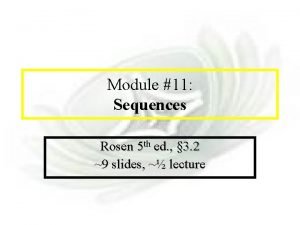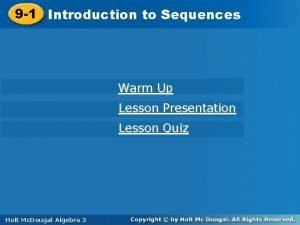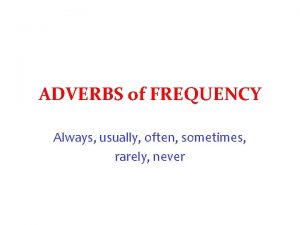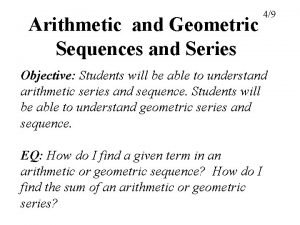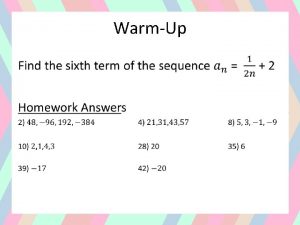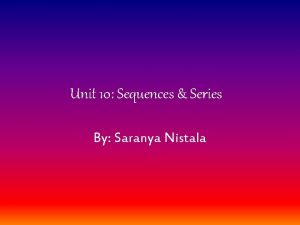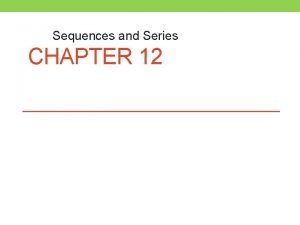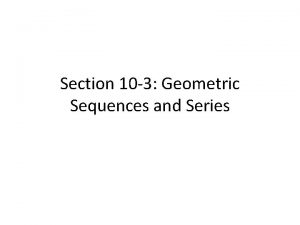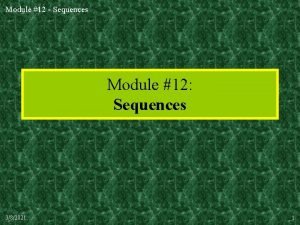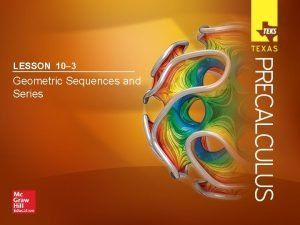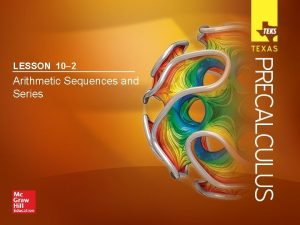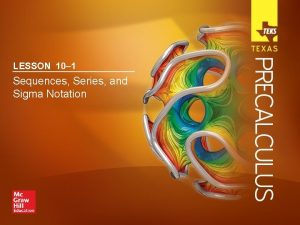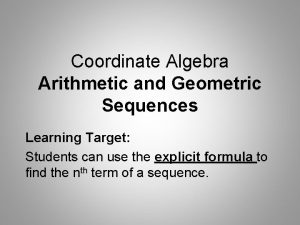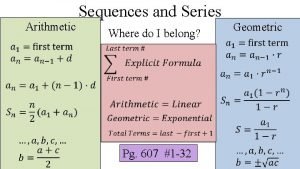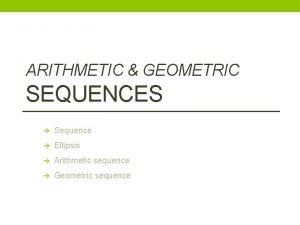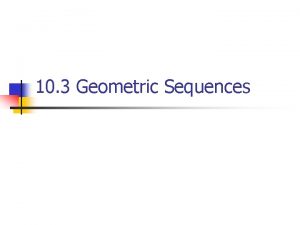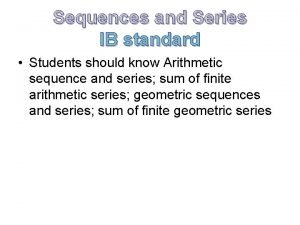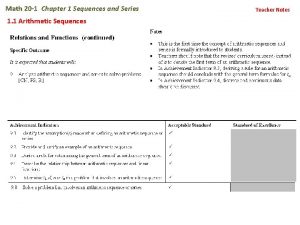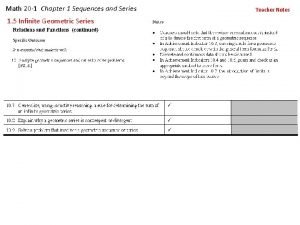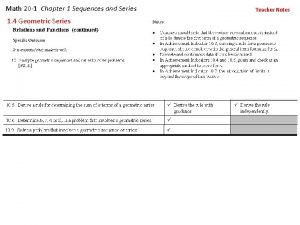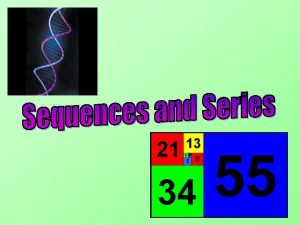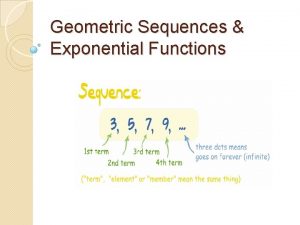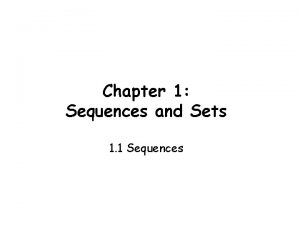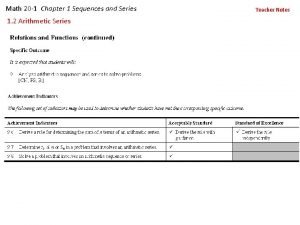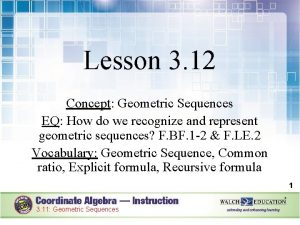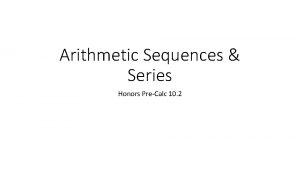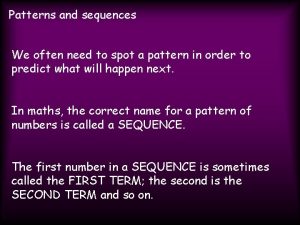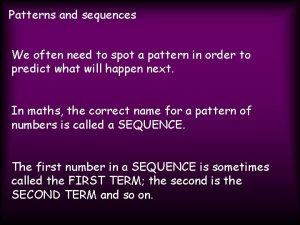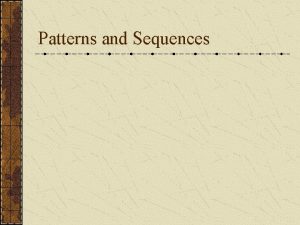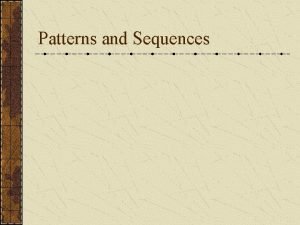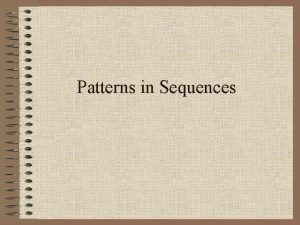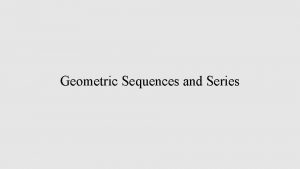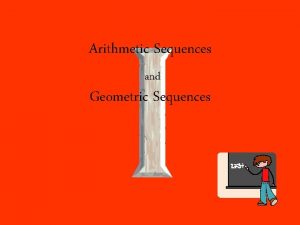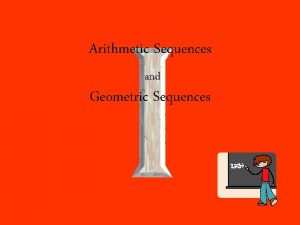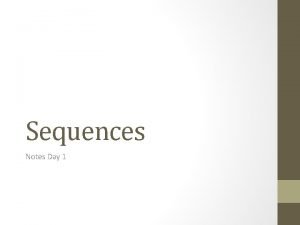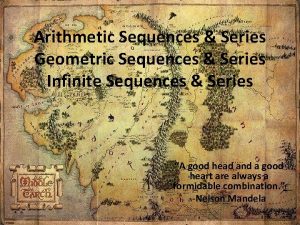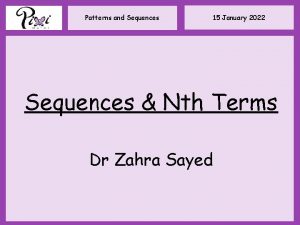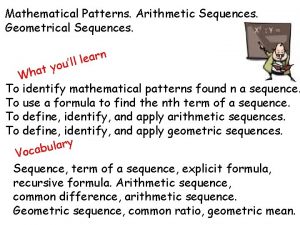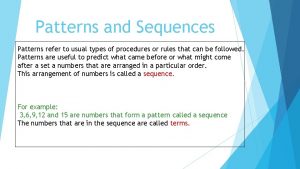Patterns and sequences We often need to spot





























- Slides: 29

Patterns and sequences We often need to spot a pattern in order to predict what will happen next. In maths, the correct name for a pattern of numbers is called a SEQUENCE. The first number in a SEQUENCE is called the FIRST TERM T 1; the second is the SECOND TERM T 2, the nth term is Tn, and so on.

Patterns and sequences For any pattern it is important to try to spot what is happening before you can predict the next number. The first 2 or 3 numbers is rarely enough to show the full pattern - 4 or 5 numbers are best.

Patterns and sequences For any pattern it is important to try to spot what is happening before you can predict the next number. 1, 2, …… What’s the next number?

Patterns and sequences For any pattern it is important to try to spot what is happening before you can predict the next number. 1, 2, 4, … Who thought that the next number was 3? What comes next?

Patterns and sequences For any pattern it is important to try to spot what is happening before you can predict the next number. 1, 2, 4, 8, 16, … What comes next?

Patterns and sequences Look at what is happening from 1 TERM to the next. See if that is what is happening for every TERM. 5, +3 8, 12, 17, 23, …

Patterns and sequences Look at what is happening from 1 TERM to the next. See if that is what is happening for every TERM. 5, +3 8, +3 X 12, 17, 23, …

Patterns and sequences Look at what is happening from 1 TERM to the next. See if that is what is happening for every TERM. 5, +3 8, +4 12, 17, 23, …

Patterns and sequences Look at what is happening from 1 TERM to the next. See if that is what is happening for every TERM. 5, +3 8, +4 12, +5 17, 23, …

Patterns and sequences Look at what is happening from 1 TERM to the next. See if that is what is happening for every TERM. 5, +3 8, +4 12, +5 17, +6 23, …

Patterns and sequences Look at what is happening from 1 TERM to the next. See if that is what is happening for every TERM. 5, +3 8, +4 12, +5 17, +6 23, +7 30, …

Patterns and sequences Now try these patterns: 3, 7, 11, 15, 19, … 128, 64, 32, 16, 8, … 10, 1, … 135, … 1000, 5, 100, 15, 45,

Arithmetic Sequence • A sequence, in which any term after the first can be obtained by adding a fixed number to the term before it, is called an arithmetic sequence. Term 1 ( T 1) = a The fixed number is called the common difference and is represented by the letter d. T 1 (a) = 2 d=2

The nth term of an arithmetic sequence When using a number sequence we sometimes need to know, for example, the 50 th or 1000 th term. To do this we need to find a rule that generates the sequence • Example : If the nth term of a sequence is 4 n – 3, write down the first 5 terms of the sequence. • • • Tn = 4 n -3 T 1 = 4(1) -3 = 1 T 2 = 4(2) -3 = 5 T 3 = 4(3) – 3 =9 T 4 = 4(4) – 3 = 13 T 5 = 4(5) – 3 = 17

Finding the nth term of an arithmetic sequence Tn = a + ( n -1)d In an arithmetic sequence 3, 8, 13, ……. Find (i) a (ii) d (iii) Tn (iv) T 20 (i) a = T 1 = 3 (ii) d = common difference = 5 (iii) Tn = a + (n -1)d = 3 + (n – 1)5 = 3 + 5 n – 5 = 5 n – 2 (iv) T 20 = 5(20) – 2 = 100 – 2 = 98

(i) Find the nth term of the arithmetic sequence 7, 10, 13, 16 Tn = a + ( n – 1) d 7+(n– 1)3 7 + 3 n – 3 3 n + 4 (ii) Which term of the sequence is 97 ? 3 n + 4 = 97 3 n = 93 n = 31 (iii) Show that 168 is not a term of the sequence. 3 n + 4 = 168 3 n = 164 / 3, since n is not a whole number, 168 is not a term in the sequence.

Finding the values of a and d If we are given any two terms of an arithmetic sequence, we can use simultaneous equations to find the value of a and d. Example: T 4 of an arithmetic sequence is 11 and T 9 = 21 Find the values of a and d and hence find T 50. Tn = a + (n – 1)d T 4 : a + 3 d = 11 T 9 : a + 8 d = 21 By using simultaneous equations, a = 5 and d = 2

Arithmetic Series • The African-American tribal celebration involves the lighting of candles every night for seven nights. The first night one candle is lit and blown out.

Arithmetic Series • The second night a new candle and the candle from the first night are lit and blown out. The third night a new candle and the two candles from the second night are lit and blown out.

Arithmetic Series • This process continues for the seven nights. • We want to know the total number of lightings during the seven nights of celebration.

Arithmetic Series • The first night one candle was lit, the 2 nd night two candles were lit, the 3 rd night 3 candles were lit, etc. • So to find the total number of lightings we would add: • 1 + 2 + 3 + 4 + 5 + 6 + 7 = 28

Arithmetic Series • Arithmetic sequence: 2, 4, 6, 8, 10 • Corresponding arithmetic. series: 2 + 4 + 6 + 8+10 • Arithetic Sequence: -8, -3, 2, 7 • Corresponding Arithmetic Series: -8 + -3 + 2 + 7

Arithmetic Series • Sn is the symbol used to represent the first ‘n’ terms of a series. • Given the sequence 1, 11, 21, 31, 41, 51, 61, 71, … find S 4 • We simply add the first four terms 1 + 11 + 21 + 31 = 64

Arithmetic Series • Find S 8 of the arithmetic sequence 1, 2, 3, 4, 5, 6, 7, 8, 9, 10, … 1 + 2 + 3 + 4 + 5 + 6 + 7 + 8 =36

Arithmetic Series What if we wanted to find S 100 for the sequence in the last example. It would be very long to have to list all the terms and try to add them up. • Let’s figure out a formula!! : )

Arithmetic Series When the terms of an arithmetic sequence are added, they form an arithmetic series. Example 1, 3, 5, 7 ……. is an arithmetic sequence 1+3+5+7 …. is an arithmetic series. We use Sn to show the sum of the first n terms. We use the following formula to find the sum of n terms of an arithmetic series.

Quadratic Sequences A sequence is a set of numbers that are connected in some way. In this section we will look at quadratic sequences where the difference between the terms changes. Consider the following sequence : Here, the differences between terms are not constant, but there is still a pattern. - the differences between each number in the sequence vary - But the second difference is a constant 2. When the second difference is constant, you have a quadratic sequence - ie, there is an n 2 term.

Quadratic Sequences Learn these rules: If the second difference is 2, you start with n 2. If the second difference is 4, you start with 2 n 2. If the second difference is 6, you start with 3 n 2.

Finding the nth term of a quadratic sequence Consider the sequence 3, 10, 21, 36 Work out each difference 7 11 15 diff is not constant Find the difference of the difference 4 4 As the difference of the difference is constant, it is a quadratic sequence Tn = an² + bn + c……. Now write T 1 and T 2 in terms of a and b T 1 = 2(1)² + b(1) + c…. . a = 2 because it is half the second difference 2 + b + c = 3 ………because we know from the sequence that T 1 = 3 b+c=3– 2 b + c = 1 ( This is equation 1) Now do the same for T 2 Tn = an² + bn + c T 2 = 2(2) ² + b(2) + c = 8 + 2 b + c = 10……. . because we know from the sequence T 2 = 10 = 2 b + c = 2 ………. . ( This is equation 2 ) You now solve for b and c, by means of Simultaneous Equations. B = 1 anc c = 0
 Module 4 patterns and sequences
Module 4 patterns and sequences Patterns and sequences module quiz b
Patterns and sequences module quiz b Usually often rarely sometimes
Usually often rarely sometimes X videos
X videos Contemporary dating patterns are formal patterns
Contemporary dating patterns are formal patterns Arithmetic and geometric sequences and series
Arithmetic and geometric sequences and series 10-2 practice arithmetic sequences and series answer key
10-2 practice arithmetic sequences and series answer key Unit 10 sequences and series homework 1 answers
Unit 10 sequences and series homework 1 answers Chapter 12 sequences and series answers
Chapter 12 sequences and series answers 10-3 geometric sequences and series
10-3 geometric sequences and series Module 12 sequences and series answers
Module 12 sequences and series answers 10-3 practice geometric sequences and series
10-3 practice geometric sequences and series 10-2 practice arithmetic sequences and series
10-2 practice arithmetic sequences and series 10-1 sequences series and sigma notation
10-1 sequences series and sigma notation How to find arithmetic sequence
How to find arithmetic sequence Geometric series formula
Geometric series formula Arithmetic explicit rule
Arithmetic explicit rule Geometric sequences formula
Geometric sequences formula Sum of gp formula
Sum of gp formula Sequences and series
Sequences and series Geometric sequence
Geometric sequence Chapter 1 sequences and series
Chapter 1 sequences and series Sequences and series math 20-1
Sequences and series math 20-1 Sequences and series
Sequences and series Exponential sequence formula
Exponential sequence formula Arithmetic sequence sigma notation
Arithmetic sequence sigma notation Linear sequence
Linear sequence Math 20-1 sequences and series
Math 20-1 sequences and series Lesson 3: arithmetic and geometric sequences
Lesson 3: arithmetic and geometric sequences Sequences and series games
Sequences and series games
